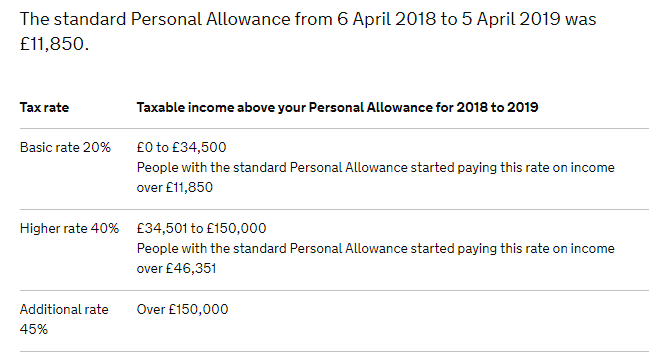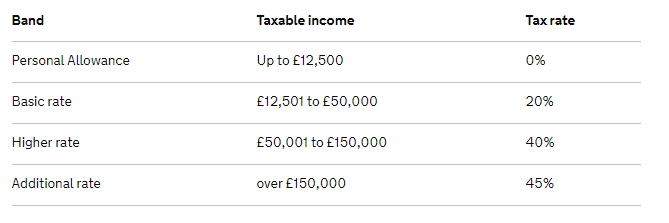How Income Tax Works In The UK
Last Updated: 14 Dec 2021
Income tax is confusing. I personally don’t feel like it was taught well (if at all) in school and because you get paid every month and income tax has already been subtracted before you receive any of money in your bank account, the calculation can all seem like a bit of a black box.
In this post I will go through the basics of how income tax is calculated and how to calculate the impact of any income tax changes that are usually announced by the government in the annual budget. First lets start with understanding the actually simple maths behind the calculations.
How Income Tax Is Calculated
For some context, let’s start with the income tax bands from last year (we’ll move onto this year’s numbers in the second section to show you how much better off you became due to the tax change).
This is a screenshot from the government page which explains the income tax bands in a slightly confusing way: https://www.gov.uk/income-tax-rates/previous-tax-years

Once you start to earn more that £100,000, the numbers I’m going to talk about below start to change a little but in the interests of keeping this article simple, I’m going to only work with numbers less than £100,000.
When thinking of the income tax, use the analogy of an ordered set of cups representing the income tax bands and a jug of water representing your income. To start calculating your income tax you start by filling up the cups in order until the jug is empty - ie once the first cup is full, you fill up the second cup and so on.
The first cup is your tax free cup, which has a size of £11,850. This is written in the screenshot above in the line after “£0 to £34,500”.
There are only 4 cups in the UK tax system but as we’re only working with numbers less than £100,00, there are only 3 cups we need to keep in mind. The cups were set up like this in the 2018/19 tax year.
| Cup | Size | Tax Rate |
|---|---|---|
| 1 | £11,850 (Size of tax free bracket) | 0% |
| 2 | £34,500 (As per the screenshot the basic rate cup) | 20% |
| 3 | £53,650 (The higher rate cup, calculated by subtracting £100,000 from (£34,500+£11,850)) | 40% |
Now that we know the cup sizes, we can easily calculate the income tax for different incomes (in this analogy think of your annual income as a large jug).
Jug 1: £29,000 – the average UK salary
This jug will fill up the cups with the following amounts:
| Cup | Size | Tax Rate | Amount of cup filled up |
|---|---|---|---|
| 1 | £11,850 | 0% | £11,850 |
| 2 | £34,500 (As per the screenshot the basic rate cup) | 20% | £17,150 (£29,000-£11,850) |
| 3 | £53,650 (The higher rate cup, calculated by subtracting £100,000 from (£34,500+£11,850)) | 40% | £0 |
To calculate the amount of income tax that will be paid, you just need to multiply the amount in the cup by its tax rate and add up all these numbers:
Total income tax = £11,850 x 0% + £17,150 x 20% + £0 x 40% = £3,430
Hence the effective tax rate you pay is just under 12% (3430/29000)
Jug 2: £10,000
This jug will fill up the cups with the following amounts:
| Cup | Size | Tax Rate | Amount of cup filled up |
|---|---|---|---|
| 1 | £11,850 | 0% | £10,000 |
| 2 | £34,500 (As per the screenshot the basic rate cup) | 20% | £0 |
| 3 | £53,650 (The higher rate cup, calculated by subtracting £100,000 from (£34,500+£11,850)) | 40% | £0 |
Total income tax = £10,000 x 0% + £0 x 20% + £0 x 40% = £0
Effective tax rate = 0%
Jug 3: £60,000
| Cup | Size | Tax Rate | Amount of cup filled up |
|---|---|---|---|
| 1 | £11,850 | 0% | £11,850 |
| 2 | £34,500 (As per the screenshot the basic rate cup) | 20% | £34,500 |
| 3 | £53,650 (The higher rate cup, calculated by subtracting £100,000 from (£34,500+£11,850)) | 40% | £13,650 |
Total income tax = £11,850 x 0% + £34,500 x 20% + £13,650 x 40% = £12,360
Effective tax rate = 21%
The 2019/20 budget
Now that we’re comfortable calculating income tax, lets see how much better off people earning each of these amounts got better off in the 2019 budget where the new tax bands were:

(source: https://www.gov.uk/income-tax-rates)
This year, the table layout is much more intuitive that before and this translates to cup sizes of the below for those who earn less than £100,000.
| Cup | Size | Tax Rate |
|---|---|---|
| 1 | £12,500 (Size of tax free bracket) | 0% |
| 2 | £37,500 (£50,000-£12,500) | 20% |
| 3 | £50,000 (£100,000 - £50,000) | 40% |
Note the lower tax brackets have larger cup sizes whereas the 40% bracket has decreased in size meaning people earning less than £100,000 will all be paying less or the same amount of tax. Let’s calculate how much things changed for the 3 scenarios above.
Jug 1: £29,000 in the 2019/20 tax year
This translates to the cups being filled up with the following amounts
| Cup | Size | Tax Rate | Amount of cup filled up |
|---|---|---|---|
| 1 | £12,500 (Size of tax free bracket) | 0% | £12,500 |
| 2 | £37,500 (£50,000-£12,500) | 20% | £16,500 |
| 3 | £50,000 (£100,000 - £50,000) | 40% | £0 |
Total tax paid in 2019/20 = £12,500 x 0% + £16,500 x 20% + £0 x 40% = £3,300
Previous year income tax = £3,430
Better off by £130
Jug 2: £10,000 in the 2019/20 tax year
| Cup | Size | Tax Rate | Amount of cup filled up |
|---|---|---|---|
| 1 | £12,500 (Size of tax free bracket) | 0% | £10,000 |
| 2 | £37,500 (£50,000-£12,500) | 20% | £0 |
| 3 | £50,000 (£100,000 - £50,000) | 40% | £0 |
Total income tax = £10,000 x 0% + £0 x 20% + £0 x 40% = £0
This person is not any better off in 2019 but then you can’t pay less income tax than £0! However, under the new rules, this person could still earn another £2,500 without paying any more income tax. Last year this tax free buffer was £1,850.
Jug 3: £60,000 in the 2019/20 tax year
| Cup | Size | Tax Rate | Amount of cup filled up |
|---|---|---|---|
| 1 | £12,500 (Size of tax free bracket) | 0% | £12,500 |
| 2 | £37,500 (£50,000-£12,500) | 20% | £37,500 |
| 3 | £50,000 (£100,000 - £50,000) | 40% | £10,000 |
Total income tax = £12,500 x 0% + £37,500 x 20% + £10,000 x 40% = £11,500
Better off by £860
Conclusion
I hope this blog post has helped you to better understand how income tax is calculated and while I did restrict my view to earners less than £100,000, the same idea applies to anyone earning 6 figures of more just with different tax free brackets.